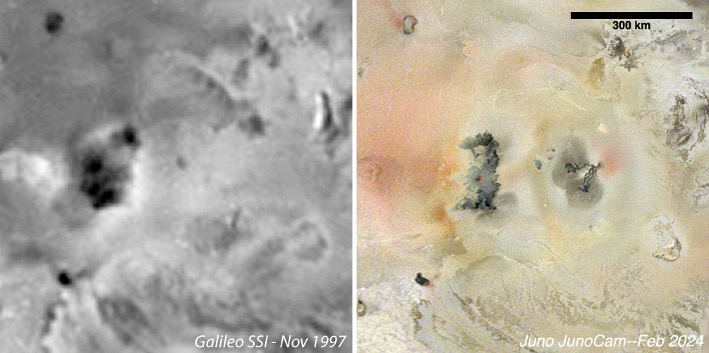Io is one of the largest moons of Jupiter and the closest of the four Galilean moons. It’s also the most volcanically active place in the Solar System, and it continues to confirm this record by revealing that it’s formed a brand new volcano in less than three decades.
The moon was last observed up close by NASA’s Galileo mission, which studied it in the late 1990s. NASA’s Juno is currently studying Jupiter and has had the chance to pass near Io a few times in recent months. The spacecraft used its JunoCam and infrared sensors to snap some photos as it did. Comparing images between the two missions, scientists noticed something: since 1997, a new volcano has appeared.
There are hundreds of active volcanoes on Io. The new one is located just south of Io’s equator and the Juno images show fresh lava flows and volcanic deposits covering an area of 32,400 square kilometers (12,510 square miles). That’s over 1.6 times the area of Wales.
“Our recent JunoCam images show many changes on Io, including this large, complicated volcanic feature that appears to have formed from nothing since 1997,” Michael Ravine, Advanced Projects Manager at Malin Space Science Systems, Inc., which designed, developed, and operates JunoCam for the NASA Juno Project, said in a statement.

Galileo’s image of the region taken in November 1997 compared to JunoCam’s from February 2024 clearly showing the new volcano.
Image credit: NASA/JPL-Caltech/SwRI/MSSS
Between 2023 and 2024, Juno conducted three flybys of Io. It took about 20 close-up images of the moon in color. They show a wealth of changes happening across the last 27 years. New lava flows have appeared, unsurprisingly across the moon’s surface, as well as more surface deposits. Nine plumes coming from the active volcanos were spotted stretching far from the Ionian surface.
The new volcano is located to the east of another volcanic feature present already in 1997. Its name is Kanehekili. The new one remains nameless for now. The best image of it was taken during the flyby of February 3, 2024.
JunoCam has delivered some incredible images and members of the public can access the raw data and do their own processing on them. Many citizen scientists have already done incredible work based on the views snapped by Juno.
“JunoCam images are created by people from all walks of life, providing a way for anyone to join our science team and share in the excitement of space exploration,” said Scott Bolton, the Principal Investigator of NASA’s Juno mission at Southwest Research Institute.
The findings have been presented at the Europlanet Science Congress (EPSC) in Berlin this week.
Source Link: Brand New Volcano Spotted On Jupiter’s Io – And It's A Big One